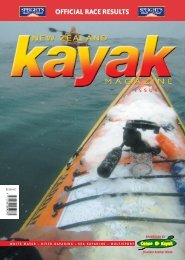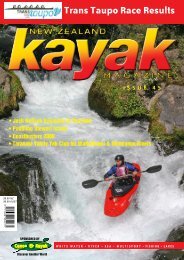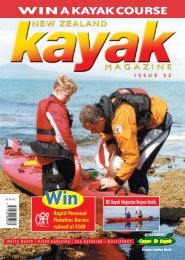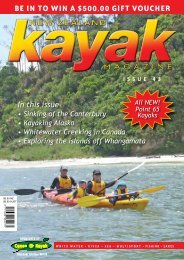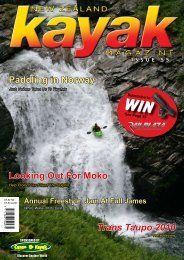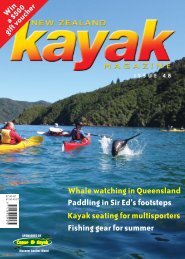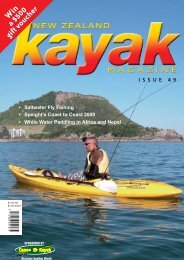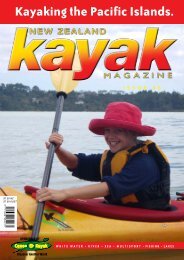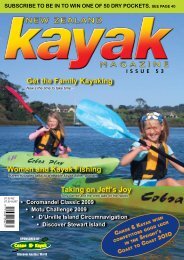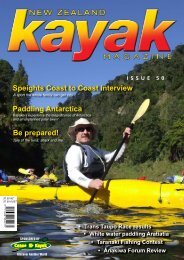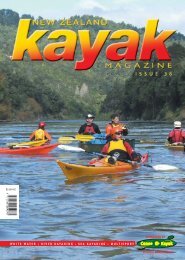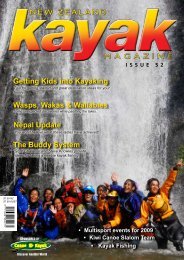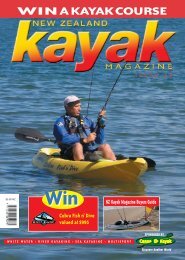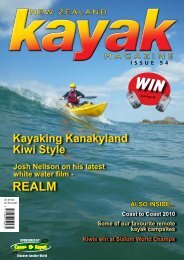w h i t e w a t e r ⢠r i V e r ⢠s e a ⢠m u l t i s p o r t ... - Canoe & Kayak
w h i t e w a t e r ⢠r i V e r ⢠s e a ⢠m u l t i s p o r t ... - Canoe & Kayak
w h i t e w a t e r ⢠r i V e r ⢠s e a ⢠m u l t i s p o r t ... - Canoe & Kayak
You also want an ePaper? Increase the reach of your titles
YUMPU automatically turns print PDFs into web optimized ePapers that Google loves.
Exploring Fiji by Shelene Paraone<br />
What an adventure:<br />
Last winter, when out paddling one cold blustery day clutching our thermos<br />
of hot coffee, I remember a remark to Andy from Wellington <strong>Canoe</strong> & <strong>Kayak</strong>;<br />
“Wouldn’t it be nice to paddle somewhere warm for a change?” As the cold<br />
days rolled on, somehow the idea took hold. Andy spent more and more time<br />
thinking of the possibilities, and before long the momentum of a dream was<br />
carrying us away on its tides.<br />
Andy found a company called Tamarillo Tropical Expeditions, (www.tamarillo.<br />
co.nz) formed in 1996, set-up and operated by Anthony Norris, Marina,<br />
Mantovani and Ratu Joseva (a traditional chief in Kadavu). With traditional<br />
culture they guide kayaking adventures for all ages and abilities. We designed<br />
our own expedition, a nine-day 165km epic adventure circumnavigating<br />
Kadavu Island. Little did we know then, but our journey would take us through<br />
tranquil, smooth, clear blue waters to some extreme weather conditions, to<br />
unforgettable views and adventure mixed with delightful local culture, food,<br />
and entertainment. We would be left with an inspirational, unique feeling of<br />
traditional villages and lifestyle with all the natural beauty Kadavu people<br />
hold close to their hearts.<br />
As winter settled in nine enthusiasts from the Wellington Yakity Yak Club,<br />
joined by a couple from Auckland, one from the U.K and one from the U.S.A<br />
flew in to Vunisia (capital of Kadavu Island). We were met by Ratu and<br />
Anthony for a boat transfer to Tamarillo’s Kadavu Island Headquarters and<br />
traditional meeting house, Ratu’s coconut plantation and Homestead.<br />
First there were speeches. Ratu welcomed us, “Bula”. This is “Hello”. A gift<br />
of Kava root was presented with chants and claps to complete the ritual.<br />
We had experienced our first ceremonial welcome and the taste for Kava,<br />
Fiji’s traditional welcoming beverage …It is polite to accept two bowls. This<br />
custom was repeated every night at each village, creating a sense of total<br />
relaxation over your whole body. It was a great way to unwind from a long<br />
day’s paddle.<br />
We sat cross-legged on a woven mat in Ratu’s Traditional meetinghouse with<br />
mosquito nets strung and tied from the ceiling of the thatched roof. This was<br />
also our sleeping quarters. We tried our first Fijian delicacy, baked kasava<br />
(similar to our sweet potato) covered in a sweet brown sugary syrup… very<br />
tasty.<br />
A spread of local delicacies awaited us for dinner. This included stuffed crabs,<br />
fresh fish, taro, rice, and taro leaves mixed in coconut cream, with lemon tea to<br />
finish. Kerosene Lanterns enhanced the ambience of the whole culture dinner<br />
experience. (Some villages have generators, but torches came in handy).<br />
We paddled 20-25km (5-6hrs) daily in double and single kayaks. It was 30<br />
degrees C when we set off in quest of adventure with four guides - Qase<br />
(pronounced Gus), Ephramie, and George, all Fijian and Nick a kiwi. Anthony<br />
was on the water with us, and Ratu was in the support boat, carrying our<br />
luggage, fresh coffee and food. The water was clear blue, and smooth. We<br />
heard the hypnotic continual deep hum of the surf folding and crashing on<br />
the distant reef. Andy brought a sail along. Attached to his kayak he moved<br />
through the water with very little effort. Definitely an ideal way to go.<br />
Gliding through the various shades of blue water we admired our surroundings,<br />
endless coconut trees, mangroves and tropical rainforest. There are lots of<br />
small villages, fanned with palm trees, along the coastline. The word “Bula”<br />
echoes from the shores as we passed the locals. We returned their friendly<br />
gesture with “Bula Morcea” (pronounced Morthea) hello and thank you. This<br />
was a regular occurrence throughout our journey.<br />
Lunch was on another white sandy beach. As on each day we had a range of<br />
food from roti stuffed with bjuja or corned beef, home made buns with either<br />
egg, tuna, banana, tamarillo jam, fresh fish with coconut cream, fresh coffee<br />
and coconuts. All these were lovingly prepared by the guides. Most days after<br />
lunch we could laze in the sun or go for a snorkel and be mesmerised by the<br />
impressive coral gardens and stunning coloured fish.<br />
On one particular day, to our surprise we saw a ‘dug out log of wood’ with a<br />
Fijian standing in the stern ‘paddling’ with a long pole, no blades attached.<br />
He cruised effortlessly and stepped on to the beach. “Bula” this young man<br />
greeted us. The dug out traditional canoe base is very rounded and the idea<br />
is you stand on the back edge for balance and use the pole to paddle.<br />
Another day we meet a met Rarumvabuka. He asked “Why did we want<br />
to spend all those hours in the water just paddling?” I guess it seemed<br />
unnecessary to paddle long stretches of ocean at a time. I smiled and said,<br />
Mt Nabukulevu and Cape Washington<br />
14 ISSUE FORTYone • 2 0 0 7



